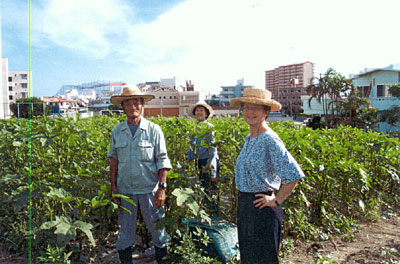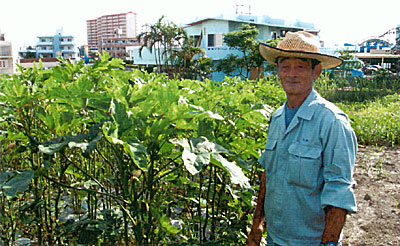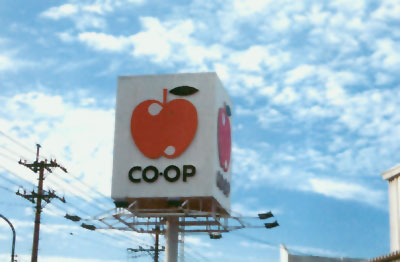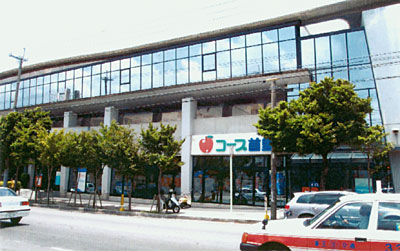 |
| Mr. Seishou Oshiro (left), Mrs. Tomiko Oshiro, Allison Wallace (right) in the Oshiros’ okra field in Tamagusku Village, Okinawa, Japan. Photo courtesy of Allison Wallace. |
By Allison Wallace
When I traveled to Japan last spring to begin a five-month Fulbright stint, I knew my grant was for lecturing rather than research, and that the time I’d need to devote to the former would leave precious little for the latter. But since I also knew that Community Supported Agriculture in the United States had been inspired by a 1960s-era Japanese endeavor, I determined to devote whatever time I could spare to finding out what had become of the Japanese version of Community Supported Agriculture. Having learned that I’d be teaching at the University of the Ryukyus, far south of the four large islands that, collectively, make up the Japanese “mainland,” I worried that researching the so-called Seikyou Movement would be difficult, thinking it might still be centered in or near its Tokyo origins. However, within a week of my arrival on Okinawa, the largest island of the Ryukyu chain, my fears were allayed: Seikyou was to be found everywhere throughout Japan, even a few blocks from the Ryukyu University campus.
So what is “Seikyou,” and what does it have to do with Community Supported Agriculture? The word itself (pronounced SAKE-yo) is short for Seikatsu Kyoodo Kumiai, which translates roughly, Living Cooperative Union. One of several hundred Japanese co-ops (unsurprisingly, a culture that deeply values community will embrace many different kinds of co-ops), Seikyou began in the mid-1960s, when some 200 Tokyo housewives, alarmed about the news of mercury poisoning among residents living near an industrially polluted lake, chose to get proactive on behalf of their families’ health. Recognizing that modern, industrial society had decided that a chemically saturated world was a price worth paying for convenient, affordable, and abundant material goods – including food – these women chose not to be so modern, not to make that trade-off if they could help it.
 |
| Mr. Seishou Oshiro of Tamagusku Village shows off the organic okra he supplies to Seikyou. He also grows goya (bitter melon), lettuce, squash and sugar cane, all organically and all in small, separate fields surrounded by development. Photo courtesy of Allison Wallace. |
They approached some local dairy farmers and proposed a deal: The householders would pay a premium to the farmers up front on their milk if the farmers would promise to produce it “cleanly,” that is, without raising their cows on feed grown or otherwise treated with chemical or synthetic inputs (pesticides, herbicides, antibiotics, and the like). The more consumers who could be recruited to the plan – and in time, many more were indeed recruited – the greater the benefits to the farmers themselves of such an arrangement. By contracting with numerous buyers in this direct manner, the dairymen would earn a greater return on their milk than was possible by selling it wholesale, into a system much like the one we’ve had for nearly a century in the States: one that funnels hefty portions of every consumer food dollar (or yen) into the pockets of processors, packagers, distributors, transporters and retailers – just about anyone but farmers. In such a simple fashion was an old idea re-born, albeit with some important modern features: The farmer extends the fruits of his labor in one hand while receiving the entirety of the consumer’s payment in the other. For their part, those Tokyo women received more than the milk for which they contracted. They also had the satisfaction of knowing they could trust it to be chem-free, and of knowing they had promoted an ecologically responsible use of natural resources. As the type and extent of their contracts with local farmers grew, they had the further satisfaction of connecting psychologically more fully with nature – the source of their sustenance – than mere grocery shopping could ever allow.
Those trail-blazing women were soon joined by others, hundreds and then thousands of others, and word gradually got out of Japan. In the mid-’80s, the news reached an energetic woman in Massachusetts who ran Indian Line Farm. Robyn Van En took the Japanese term for Seikyou’s basic approach, “teikei,” which translates simply, “contract,” and gave it its philosophical spin, calling it “food with a face.” Recognizing that this phenomenon held within it the seeds of something more powerful than simply another form of direct marketing, she soon turned Indian Line Farm into the first American farm to be called a CSA. Through Van En’s work and that of numerous others, the concept of Community Supported Agriculture (Van En’s phrase) quickly gained ground in the United States, first along the East and West Coasts. Variations on the basic theme, “a community-based organization of producers and consumers” (Groh and McFadden, p. 225), proliferated. The numbers are difficult to track – some CSAs prove short-lived, and new ones come into being each growing season – but at last count, more than 1100 CSAs existed across the United States.
Perhaps because the CSA movement in America originated more with producers than with consumers – and new outfits continue to be initiated most often by farmers – it soon took on a different character than that of its Japanese inspiration. Whereas members of a CSA farm have, in most cases, contracted with one producer for a limited number of foods (and sometimes fibers) deriving from a single locale, usually one in the general neighborhood of the consumer-members’ homes, Japan’s Seikyou movement has not looked anything like this for a long time.
 |
| Although Japan is home to many kinds of co-ops, this sign designates the Seikyou type. Photo courtesy of Allison Wallace. |
Which takes me back to my story. By the early ’70s, Seikyou interest spread beyond safe milk to include safe eggs, pork, vegetables, and a great deal more. The emphasis on local suppliers that had been part of the original approach gradually took a back seat to the goal of connecting concerned consumers with socially and environmentally benign products, no matter where they originated. (Although most suppliers remain Japanese, some goods are imported from China, Australia and the United States.) Moreover, Seikyou membership was going through the roof, so the group had to get smart about managing its own success. To this day, the 140,000-plus Seikyou members are divided into regional blocks called “hans,” which operate chiefly as buying clubs. Each han’s members gather periodically to order goods from catalogs highlighting producers that the Seikyou leadership has identified, vetted, and contracted with ahead of time; in this manner, members supply themselves with virtually all the same products they could find in an ordinary Japanese supermarket – from foodstuffs to paper goods and from pet supplies to health and beauty aids – with the difference that these products can be trusted to have environmentally safe origins.
When conscientious producers of a given item cannot be found readily, some Seikyou members may band together to create a workers’ co-op dedicated to its manufacture. This is how Japanese-made, phosphate-free soaps and detergents became available to Seikyou consumers fairly early in the group’s history. In recent years, the movement has gotten well beyond material goods, venturing into services: Seikyou members now use their collective buying power to get good deals in movie and concert tickets; in meal delivery to the house-bound; and in babysitting, elder care and house cleaning services. Seikyou has even launched its own travel and insurance agencies.
When Seikyou membership spread beyond Tokyo to Kanagawa Prefecture in the ’70s, the movement opened its first store front, thereby making conscientious shopping that much more visible and available to the public. (Whereas Seikyou membership is required for participation in the hans, it is not required of shoppers who visit the stores.) More than 2500 Seikyou stores now exist all across Japan, including five in its most remote prefecture, Okinawa; they are distinguishable from ordinary stores by the logo in their sign, a big red apple with the word “Co-op” in large black letters underneath.
But what American, familiar with the typical CSA operation and on the lookout for its Japanese prototype, would think to look toward a clean, attractive, yet otherwise unremarkable grocery store? Imagine my bewilderment when a Japanese colleague, learning of my interest, offered to take me on a tour of the Seikyou supermarket closest to our university campus. “But wait, Hanashiro-sensei,” (Professor Hanashiro) “where are the farms?”
Those, it turns out, are all over the place – all over the country, even (as noted above) in other countries. And many of the farms are likely to comprise several different small fields lying some distance from each other as well as from the farmers’ residences, since sizable chunks of arable land not already dedicated to industrial agricultural production are difficult to come by in mountainous Japan. Couple this fact with the traditional Japanese reluctance to have strangers (or even known acquaintances) come to one’s home, and one can see why a farm-centric CSA profile is not the rule in Japan as it is in the States. So how do products coming off these farms – the ones located in Japan, anyway – get into the hands of Seikyou members, be they store or catalog shoppers? Through the distribution work of – you guessed it – farmers’ cooperatives, especially one called J.A., for Japan Agriculture. But that’s another chapter to the story altogether.
 |
| The front of a Seikyou market in the village of Shuri, Okinawa, Japan. Photo courtesy of Allison Wallace. |
Reference: Groh, Trauger, and Steven McFadden. Farms of Tomorrow Revisited: Community Supported Farms – Farm Supported Communities. Kimberton, PA: Biodynamic Farm and Gardening Association,1997; 2000.
About the author: Originally from New Orleans, Louisiana, Allison earned her Ph.D. in American environmental writing at the University of North Carolina at Chapel Hill, then worked for Unity College in Unity, Maine, for nine years, where her teaching and research moved increasingly into the area of sustainable agriculture. An avid gardener, beekeeper, and currently professor of American Studies in the Honors College of the University of Central Arkansas, she has been a MOFGA member since the early ’90s; she is also a member of the Carolina Farm Stewardship Association (CFSA) and the Arkansas Farm Community Alliance (AFCA).

